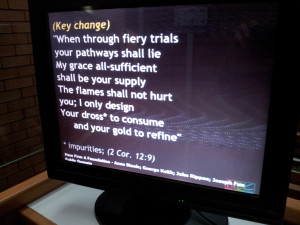
A few months ago I read an interview with Matt Boswell and Michael Bleecker. As a fellow worship leader, one of their answers piqued my interest:
Trevin Wax: What are some practical steps you’d recommend for worship leaders who want to incorporate a more Scripture-focused, gospel-centered approach to their ministry?
Michael Bleecker: I would begin with the songs they sing. Do they understand everything they are singing so that they’re able to teach it? Are the lyrics of their songs biblical? Have they taken the time to match Scriptures to the lyrics?
On each of my charts I have a few Scriptures typed in at the top so I’m able to reference them while I’m singing, playing or praying. I also add Scriptures to the bottom of the slides so the church is able to reference them while they are singing as well.
If we’re singing “here I raise my Ebenezer,” 1 Samuel 7:12 will be at the bottom of that slide. If we’re singing “my name is graven on His hands,” Isaiah 49:16 will be at the bottom of that slide. The slides aren’t as clean as they were before, but it’s a great trade for informed worshipers.
We’ve been adding footnotes at our home church for several songs now, and have received lots of positive feedback about it. At our recent conference, the guest speaker even said he’d borrow the idea for his home church!
If you’re leading worship or teaching others using songs, here’s some of my expanded thoughts on why footnotes and explanations are worth adding to your projected worship lyrics.
Biblically inform
Good worship songs are saturated with truths from the Bible.
For example:
- each verse of “How Firm A Foundation” refers to a promise from God’s Word for His people.
- The bridge of “Blessed Be Your Name” quotes Job’s response to suffering (Job 1:20-21)
- The Sovereign Grace song “Name Above All Names” traces the Christ-exalting verses in Philippians 2:5-11.
By adding the relevant Bible verse at the bottom of the slide, you not only help church family see the connections between the lyrics and the scriptures they quote or reference, but also encourage them to think through what they’re singing.
Granted, most people won’t be rifling through their bibles to look stuff up as they sing. Then again, maybe if it’s there, some might! In addition, the cumulative effect of realising that we’re singing God’s Word to each other – distilled and melodiously memorable – can be powerful. (yes! what we sing is true!).
Adding bible references on projected lyrics can therefore be a wonderful help as we address, teach and admonish one another in song (Col 3:16, Eph 5:19).
Clarify vocabulary
When Christians sing together, we’re frequently singing lines that we don’t understand.
Don’t believe me? See if you can explain each of these lines to a new Christian:
- “Thine eye diffused a quickening ray“ (sounds like a line from Star Wars…)
- “I dare not trust the sweetest frame” (like a window into your soul, right?)
- “Nothing compares to the promise I have in you“ (what’s the promise?)
- “He then is my hope and stay” (stay where?)
- “Gladly for aye we adore him” (aye?)
If Christians don’t fully understand these, consider how bizarre some of our worship lyrics could be for a new Christian, people who have little or no Bible knowledge, and English-as-second-language speakers!
With discernment, adding brief footnotes on your projected lyrics can help people to sing the words with better understanding. Sure, it’s no substitute for a detailed verbal explanation. But by putting it on screen, you’re helping to clarify worship vocabulary to your entire church in one fell swoop.
Adding word explanations on your projected lyrics can therefore be an easy way to clarify what they mean, which means better-informed worshippers.
Practical benefits
Here’s some other ways that using footnotes on your projected lyrics can improve your gathered worship.
Add it once, teach it repeatedly: Let’s say as a song leader or pastor you really want people to understand a word in a lyric. So one Sunday morning you give a helpful and detailed explanation about what Ebenezer means. But then 6 months later, you’ve got new Christians in your congregation who are again, puzzled by this reference. In addition, half your congregation have forgotten what you’d originally said! A good footnote on the projected lyrics lets you teach and reteach new and existing church family what your songs mean.
Think about the words: Going through the practice of footnoting encourages me to think harder about the songs being chosen. If there’s next-to-nothing in the song that I can identify Scripture to, then I need to ask myself if it’s worth singing. If every line requires a footnote to explain what the words mean, perhaps words could be changed or another song chosen to better communicate the same ideas. So in the long-term, you may end up moving towards words with more Scripture, or gravitate towards texts that more people understand.
A pastoral view of songs: By thinking through song lyrics and what they mean, it helps pastors and worship leaders to view worship in song not just as music-mediated communion, but as a formative in shaping the beliefs of our congregation. When you can clarify that “sweetest frame” in “The Solid Rock” refers to an emotional state, it becomes a mini-teaching moment to your brothers and sisters that we don’t trust our feelings, no matter how good or bad, we put our trust in Jesus and His constant promises instead. And so I think by footnoting worship lyrics, pastors have a simple yet effective means to shape what their flock believes and hopes in (and you don’t need to know music to do it!).
Anyways, that’s enough for now. In my next post I’ll share some resources to help worship leaders and pastors to get helpful footnotes on your projected lyrics.
But for now, try footnoting a song you’ll be singing this Sunday, and tell me how it goes!






